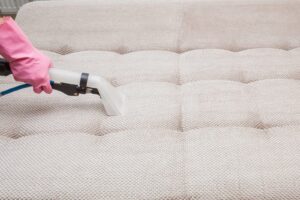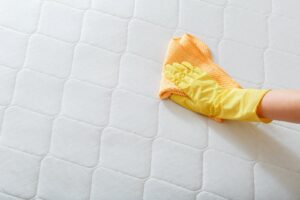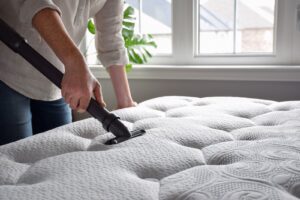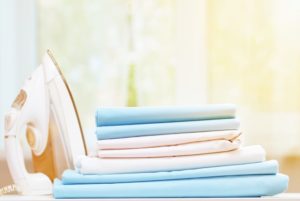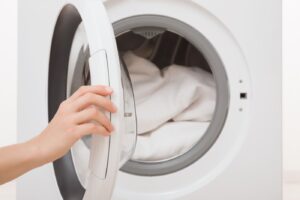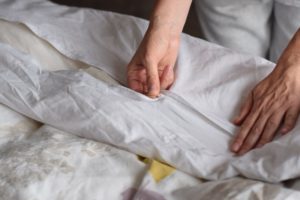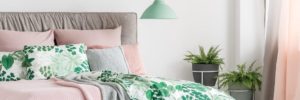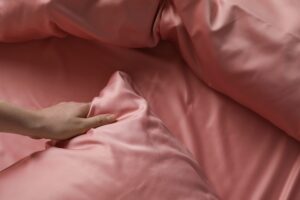Linen vs. Cotton Sheets
- Linen sheets are breathable and have a luxurious, distinctive feel. Cotton sheets are widely available in various types, styles, and colors and tend to be more affordable than linen. Both linen and cotton are made with natural materials, soften with age, and are moisture-wicking, but linen is more durable over time.
Linen and cotton sheets are made from breathable natural plant fibers. While both types of sheets do a good job of wicking moisture, they differ in how they look, feel, and function. Price and longevity are also important factors to consider when choosing between linen and cotton sheets.
We’ll compare linen and cotton sheets, discussing their feel, durability, and price. We’ll also provide some tips on how to care for each so you can decide which type of sheet is best for you.
What Are Linen Sheets?
Linen sheets are made with a woven fabric derived from the flax plant.
Linen sheets have a distinctive crinkled look. At first, they may feel stiff or rough to the touch, but every washing makes these sheets softer. Linen sheets that are labeled “pre-washed” or “stonewashed” will often be softer to begin with.
Linen sheets can last for a long time, as the fibers are very strong and durable. Linen sheets are also very breathable and quick to dry, making them a good choice for sleepers trying to stay cool in warmer temperatures.
Is Linen More Breathable Than Cotton?
Thanks to its looser weave, linen is more breathable than cotton. Linen allows for more airflow and doesn’t trap heat as much as other fabrics can. It also wicks moisture away from skin, which can help keep sleepers cool.
The weight of the linen, measured in grams per square meter (GSM), can determine its breathability. Linen sheets weighing around 170 GSM are fairly light, making them a good choice for hot sleepers. Heavier sheets weighing up to 190 GSM may be better for cold sleepers or cooler climates.
What Are Cotton Sheets?
Cotton sheets are made with fabric derived from the cotton plant. Cotton is the most common material used in sheets and is known for its softness and breathability.
Cotton sheets vary in texture and feel according to the fabric’s weave. A percale weave uses a one-over-one-under pattern of fibers for a crisp feel. A sateen weave uses a one-under, three- or four-over pattern of fibers and is a little softer and shinier.
High-quality cotton sheets can last for 5 to 10 years. Cotton sheets are easy to clean and become softer after every wash.
What Types of Cotton Are Found in Sheets?
There are three main types of cotton used to make sheets.
Egyptian cotton is considered the most luxurious type of cotton. Sheets made from this material use extra-long fibers for a soft, smooth, breathable fabric that keeps the sleeper cool and dry. True 100% Egyptian cotton sheets may cost as much as $400 for a set. Less expensive options are likely a blend of cottons and not pure Egyptian cotton.
Pima cotton is a more moderate option in terms of price. It was first grown in Peru but is now also farmed in the U.S. Pima cotton sheets are made with extra-long staple cotton that is breathable and moisture-wicking.
Upland cotton is the most common and generally most affordable cotton used in sheets. This material has shorter fibers, which makes the sheets a little rougher and less durable than Pima or Egyptian cotton. More than 95% of cotton grown in the U.S. is upland cotton.
| Egyptian Cotton | Pima Cotton | Upland Cotton |
|---|---|---|
| Look & Feel: Egyptian cotton is luxurious, light, and crisp. It is breathable and feels soft and smooth against the skin. It is strong, durable, and doesn’t pill. | Look & Feel: Pima cotton feels soft to the touch and is light and breathable, as well as moisture-wicking. It is more durable than less expensive cotton. | Look & Feel: Upland cotton is a little coarse, but it becomes softer with every wash. It is lightweight and breathable, but prone to pilling, ripping, and fraying. |
Linen vs. Cotton Sheets: Pros & Cons
Linen sheets are more breathable and last longer than cotton sheets. However, their coarser feel and more wrinkled look may not appeal to everyone. Cotton sheets are available in a larger variety of colors and patterns. They are often more affordable than linen sheets, but they may not be as durable.
| Linen Sheets | Cotton Sheets |
|---|---|
Pros:
|
Pros:
|
Cons:
|
Cons:
|
Which Is Best for Your Needs?
Both linen and cotton sheets are made from natural fibers, producing breathable, moisture-wicking sheets that will become softer over time. High-quality Egyptian cotton sheets and linen sheets can look and feel very luxurious, which is reflected in their higher cost. Sheets made with upland cotton are generally more affordable and easier to find.
| Linen Sheets | Cotton Sheets |
|---|---|
| Price Range: $300 – $600 for a queen size set | Price Range: $150 – $250 for a high-quality queen size set |
|
Care & Maintenance: Follow the washing directions on the label. Linen sheets are usually machine-washable using mild detergent in cold water on a short or gentle cycle. Do not use fabric softener or chlorine bleach. To avoid wrinkles, remove the sheets from the dryer while they are still a little damp and hang them to dry. |
Care & Maintenance: Follow the washing directions on the label. Cotton sheets are usually machine-washable and can be dried on low heat to prevent shrinking. Avoid hot water and harsh detergents. You can use fabric softener and iron them to reduce wrinkles. |
|
You’ll Want Linen Sheets If:
|
You’ll Want Cotton Sheets If:
|

Still have questions? Ask our community!
Join our Sleep Care Community — a trusted hub of sleep health professionals, product specialists, and people just like you. Whether you need expert sleep advice for your insomnia or you’re searching for the perfect mattress, we’ve got you covered. Get personalized guidance from the experts who know sleep best.

